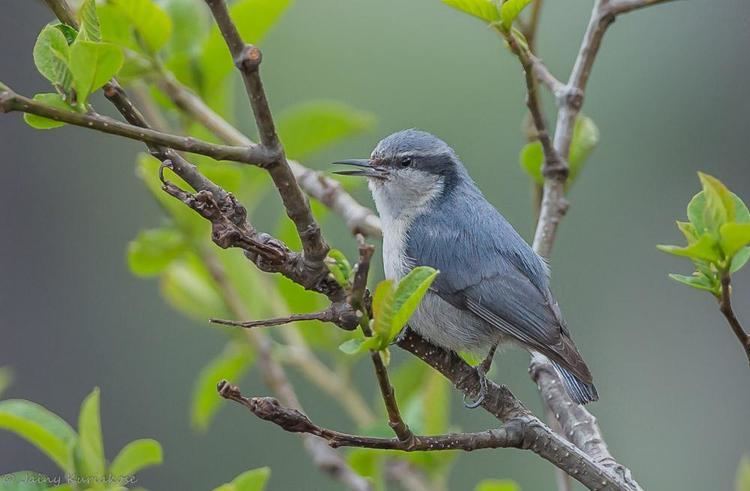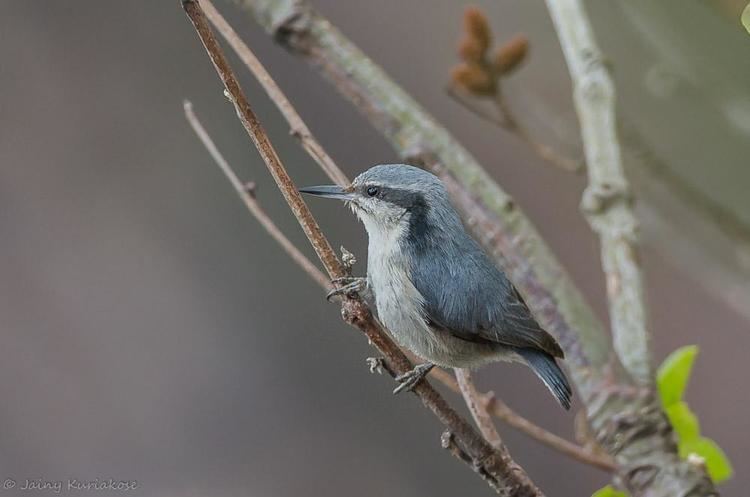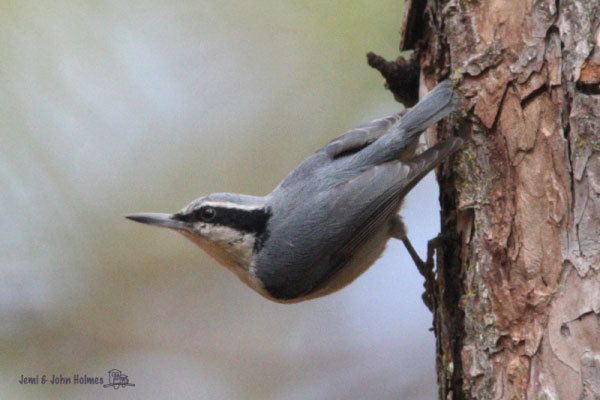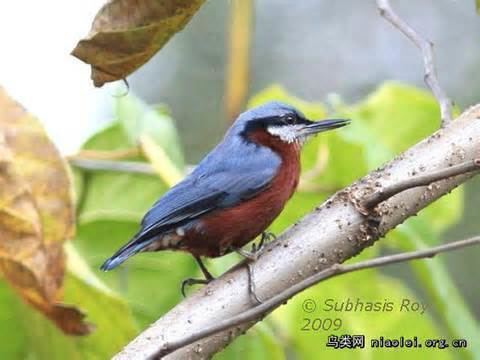Order Passeriformes Genus Sitta Higher classification Nuthatch | Phylum Chordata Family Sittidae Scientific name Sitta yunnanensis Rank Species | |
 | ||
Similar Nuthatch, Bird, White‑cheeked nuthatch, White‑browed nuthatch, Sitta magna | ||
The Yunnan nuthatch (Sitta yunnanensis) is a species of nuthatch endemic to South-Western China. It was first described by William Robert Ogilvie-Grant in 1900 based on a male holotype, and it occurs in pine forests at altitudes of up to 4,000 m (13,000 ft).
Contents

This blue-grey bird can be up to 12 centimetres (4.7 in) long, has a distinctive white eyebrow, and exhibits a small degree of sexual dimorphism. This noisy bird's diet consists of insects it finds on pine branches, and it is generally rare but can be locally common. Categorised as a near-threatened species on the IUCN Red List, it has a small range of 170,000 square kilometres (66,000 sq mi), and a 2009 study predicted that its population could decrease by 43.6% to 47.7% by between 2040 and 2069.

Description

The upper parts of the Yunnan nuthatch are blue-grey, including the calotte, despite being separated from the upper mantle by a paler area. It has a thin white eyebrow, which extends to the front of the bird and is above the black eye line. Each eye has a fine white circle around it, and it has a white cheek and throat. The lower parts are pale and unified, and the grey-black beak is sharp and pointed with a yellowish base. Its irises are dark brown, and the legs and feet are grey-brown. The Yunnan nuthatch is a small nuthatch, measuring around 12 cm (4.7 in) in length, and its wing chord is 69.5 to 74 millimetres (2.74 to 2.91 in) on male specimens and 67 to 74 millimetres (2.6 to 2.9 in) on female specimens. On males, the tale measures 35 to 41 millimetres (1.4 to 1.6 in) and on females, it measures between 36 and 38 millimetres (1.4 and 1.5 in). Its beak measures between 16.8 and 19.5 millimetres (0.66 and 0.77 in), the tarus is 14.8 to 19 millimetres (0.58 to 0.75 in) in length, and it weighs between 7.5 and 13 grams (0.26 and 0.46 oz).

It exhibits little sexual dimorphism, but when the black eye trait is shown on females, their eyes are duller and greyer than those of males. The plumage is fresh in August and gradually gets worn away until the following spring. In worn plumage, the whitish feathers forming the ends of the eyebrows are worn, and the eyebrow line becomes discontinuous or inconspicuous, and the upper parts of the bird become duller. Its tail feathers and wings wear, but the blue-grey feather tips exist until at least May. The lower parts tarnish and become increasingly "dirty", and become a greyish-white colour. Sometimes, the eyebrow does not fully extend to the front. The eye line becomes narrower, and the cheek of the bird becomes grey, instead of white. The throat remains white, but the underside of the bird becomes duller, and less pale in adult specimens. Adult specimens molt from July to September, and there is sometimes a partial molt between January and February, prior to the breeding season.

The giant nuthatch can occur in the same habitat as the Yunnan nuthatch, but lacks a white eyebrow. The chestnut-vented nuthatch is more similar in size to the Yunnan nuthatch than the giant nuthatch, but is different in colour and also lacks a white eyebrow.
Voice
The Yunnan nuthatch is a fairly noisy bird, and typically makes many individual sounds: nit, kni, tit, pit, or a low and nasal toik. Its cry, nit, is repeated in sets lasting four to ten seconds of five to six repetitions per second, produsing a kni-kni-kni, kit-kit-kit, pi-pi-pi, or a nasal niew-niew-niew sound. It also produces a harsh schri-schri-schri or szi-szi-szi cry, a trait shared by other small nuthatches. It sometimes produces a ziew-ziew-ziew cry in calm sets of three notes per second, and can also emit nasal cries quit-quit-quit, schu-schu-schu, or tui-tui-tui.
Food and breeding
The diet of the Yunnan nuthatch is not well-known, but it is known to consume insects it catches on pine branches. There is a lack of information about its reproduction, but a female was collected on 9 March that was close to laying, while recently born Yunnan nuthatches were collected on 21 May.
Distribution and habitat
It is endemic to South-West China, and mainly occurs in Lushui County, Jinggu Dai and Yi Autonomous County, Shiping County, Kunming, Huidong County, Yajiang County, Xichang, Guizhou, and in Zayü County. A study published in 2003 identified the species being endemic to China, and identified the Hengduan Mountains as the main area of endemism.
The Yunnan nuthatch is a sedentary species. It exists in pine forests with sparse undergrowth, and avoids dense spruce and fir forests. Occasionally, it occurs on small pine trees 2 to 3 m (6.6 to 9.8 ft) high, in open forests or among scattered groups of trees. In the summer, it lives at altitudes between 2,440 and 3,960 m (8,010 and 12,990 ft) above sea level (ASL), and travels down into valleys during winter to heights up to 1,200 m (3,900 ft) ASL. However, it has been observed at between 2,600 and 4,000 m (8,500 and 13,100 ft) ASL between November and January in Shuangbai County.
Taxonomy
The Yunnan nuthatch was first described as Sitta yunnanensis by Scottish ornithologist William Robert Ogilvie-Grant in 1900 based on a male holotype brought from southern Yunnan by Capt. Alfred Woodrow Stanley Wingate. It was placed into subgenus Micrositta by Buturlin in 1916, although nuthatch species are now generally grouped together under genus Sitta. According to the International Ornithological Congress and ornithologist Alan P. Peterson, there are no subspecies. In 2014, Eric Pasquet et al. published a phylogeny confirming the relationship between the Micrositta species, and found the Yunnan nuthatch to be the most basal species of the group.
Threats and protection
In 1987, Zheng Zuoxin described the Yunnan nuthatch as rare, but it is locally common in areas such as Lijiang's pine forests. It has a small range of around 170,000 square kilometres (66,000 sq mi), and the bird disappeared from several locations in the early twentieth century. It is threatened by habitat destruction and is dependent on old pine forests, but also appears to live in degraded habitats. A 2009 study attempted to predict the impact of climate change on nuthatches in Asia, and shows the Yunnan nuthatch's distribution decreasing by between 43.6% and 47.7% by 2040–2069. It is categorised as a near-threatened species on the IUCN Red List.
